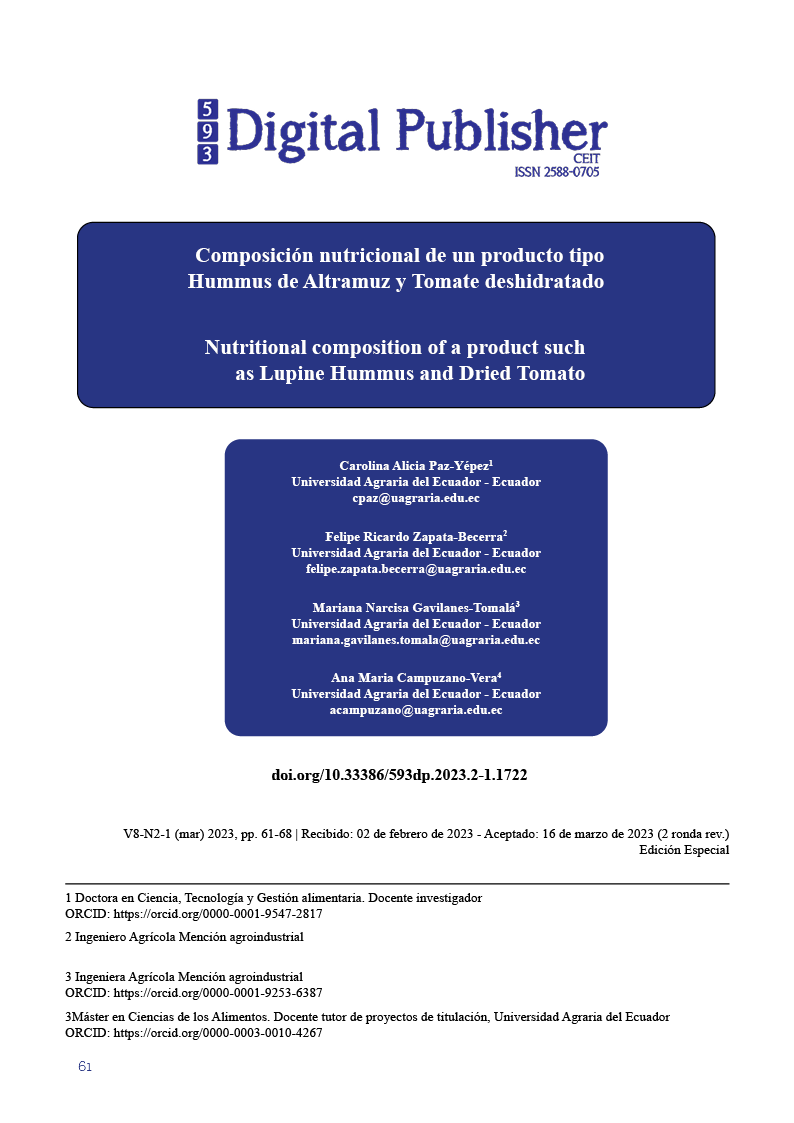Nutritional composition of a product such as Lupine Hummus and Dried Tomato
Main Article Content
Abstract
The present investigation was developed to evaluate the nutritional content and determine the organoleptic acceptance of a hummus-type product using lupine and dehydrated tomato as the main raw material, which are produced locally in the Ecuadorian territory, promoting the production and generating the industrialization of Andean products accessible and beneficial for health. A formulation was developed applying 56% lupine and 30% dehydrated tomato, the nutritional content was evaluated obtaining the following results: 30.51% protein, 7.12% fiber, 10.43% carbohydrates; 3.2mg/100g iron; 7.2 mg / 100 g of calcium and finally 5.90% of total fat, presenting a higher protein content and sensory acceptance compared to a commercial hummus, thus showing that the application of lupine affects the nutritional value of the product and the dehydrated tomato. in the sensory acceptance of the panelists.
Downloads
Article Details

This work is licensed under a Creative Commons Attribution-NonCommercial-ShareAlike 4.0 International License.
1. Derechos de autor
Las obras que se publican en 593 Digital Publisher CEIT están sujetas a los siguientes términos:
1.1. 593 Digital Publisher CEIT, conserva los derechos patrimoniales (copyright) de las obras publicadas, favorece y permite la reutilización de las mismas bajo la licencia Licencia Creative Commons 4.0 de Reconocimiento-NoComercial-CompartirIgual 4.0, por lo cual se pueden copiar, usar, difundir, transmitir y exponer públicamente, siempre que:
1.1.a. Se cite la autoría y fuente original de su publicación (revista, editorial, URL).
1.1.b. No se usen para fines comerciales u onerosos.
1.1.c. Se mencione la existencia y especificaciones de esta licencia de uso.
References
Abdullahi, I. I., Abdullahi, N., Abdu, A. M., y Ibrahim, A. S. (2016). Proximate, mineral and vitamin analysis of fresh and canned tomato. Biosciences Biotechnology Research Asia, 13(2), 1163-1169.
AOAC. (1990). Método Hidrólisis Ácida-Soxhlet. https://www.yumpu.com/es/document/read/14908141/procedimiento-para-determinar-materia-grasa-metodo-
AOAC. (1995). Official Method 991.43. Total, Soluble, and Insoluble Dietary Fibre in Foods.
Aschemann-Witzel, J., Gantriis, R. F., Fraga, P., y Perez-Cueto, F. J. A. (2020). Plant-based food and protein trend from a business perspective: markets, consumers, and the challenges and opportunities in the future. Critical Reviews in Food Science and Nutrition, 0(0), 1–10. https://doi.org/10.1080/10408398.2020.1793730
Bhatkar, N. S., Shirkole, S. S., Mujumdar, A. S., y Bhaskar, N. (2021). Drying of tomatoes and tomato processing waste : a critical review of the quality aspects. Drying Technology, 39(11), 1720–1744. https://doi.org/10.1080/07373937.2021.1910832
Björklund, D. (2020). Hummus: la comida rápida saludable que crece rápidamente. El hummus cambia de ser una comida tradicional a un refrigerio moderno en el mundo acelerado actual.
Boukid, F., Pasqualone, A. (2022). Lupine (Lupinus spp.) proteins: characteristics, safety and food applications. Eur Food Res Technol, 345–356. https://doi.org/10.1007/s00217-021-03909-5
Cabrera Pozo, M. N. (2011). Valoración de la Calidad de la Dieta Aplicando el Ïndice de KIDMED en los Estudiantes de los Colegios Capitán Edmundo Chioriboga y Unidad Educativa El Verbo de la Ciudad de Riobamba.
Caicedo, C., y Peralta, E. (2000). Zonificación potencial, sistemas de producción y procesamiento artesanal del chocho (Lupinus mutabilis Sweet) en Ecuador.
Chaudhary, P., Sharma, A., Singh, B., y Kaur, A. (2018). Bioactivities of phytochemicals present in tomato. Journal of Food Science and Technology. https://doi.org/10.1007/s13197-018-3221-z
Elbadrawy, E., y Sello, A. (2011). Evaluation of nutritional value and antioxidant activity of tomato peel extracts. ARABIAN JOURNAL OF CHEMISTRY. https://doi.org/10.1016/j.arabjc.2011.11.011
Espinosa, J. M. (2013). La ciencia sensorial: su incidencia en la calidad del servicio de alimentos y bebidas y la satisfacción del cliente. 1–2. https://es.scribd.com/doc/314294316/La-Ciencia-Sensorial
FAO. (2016). “Simposio Regional Del Chocho o Tarwi (Lupinus Mutabilis).
Gamarra Castillo, F., Castañeda Castañeda, B., Castillo Belsuzarri, M., y Martinez Herrera, J. (2006). Gastric anti-inflamatory and anti-secretory activities in rats treated with an aqueous Lupinus mutabilis extract. In México, where old and new world lupins meet. 347–349.
Grabowska, K. J., Zhu, S., Dekkers, B. L., De Ruijter, N. C. A., Gieteling, J., y Van Der Goot, A. J. (2016). Shear-induced structuring as a tool to make anisotropic materials using soy protein concentrate. Journal of Food Engineering, 188, 77–86. https://doi.org/10.1016/j.jfoodeng.2016.05.010
Hemalatha, S., Gautam, S., Platel, K., y Srinivasan, K. (2009). Influence of exogenous iron, calcium, protein and common salt on the bioaccessibility of zinc from cereals and legumes. Journal of Trace Elements in Medicine and Biology, 23(2), 75–83. https://doi.org/10.1016/j.jtemb.2009.01.005
Iqbal, A., Khalil, I. A., Ateeq, N., y Sayyar Khan, M. (2006). Nutritional quality of important food legumes. Food Chemistry, 97(2), 331–335. https://doi.org/10.1016/j.foodchem.2005.05.011
Kaur, M., y Singh, N. (2007). Characterization of protein isolates from different Indian chickpea (Cicer arietinum L.) cultivars. Food Chemistry, 102(1), 366–374. https://doi.org/10.1016/j.foodchem.2006.05.029
Kohajdová, Z., Karovičová, J., y Schmidt, Š. (2011). Lupin Composition and Possible Use in Bakery – A Review. 29(3), 203–211.
Lenucci, M. S., Cadinu, D., Taurino, M., Piro, G., y Dalessandro, G. (2006). Antioxidant Composition in Cherry and High-Pigment Tomato Cultivars. 2606–2613.
Llerena, L. (2022). BENEFICIOS DEL CHOCHO PARA MEJORAR LA NUTRICIÓN. Revista Qualitas, 24(24), 066-075.
López-Legarda, X., Taramuel-Gallardo, A., Arboleda-Echavarría, C., Segura-Sánchez, F., y Restrepo-Betancur, L. F. (2017). Comparación de métodos que utilizan ácido sulfúrico para la determinación de azúcares totales. Revista Cubana de Química, 29(2), 180-198.
Mattice, K. D., y Marangoni, A. G. (2020). Evaluating the use of zein in structuring plant-based products. Current Research in Food Science, 3, 59–66. https://doi.org/10.1016/j.crfs.2020.03.004
May, B. (2004). Dehydrated tomatoes. In FOOD SCIENCE AND TECHNOLOGY (NEW YORK M, pp. 395-408.).
Mazón, N. V. C. (2019). Análisis comparativo de la composición nutricional del chocho, quinua y soya, y su aplicación en la elaboración de harinas. La Ciencia Al Servicio de La Salud, 10(Ed. Esp, 260-269.
Minaya Agueroa, C. (2016). Viscosidad de una salsa de Tarwi (Lupinus mutabilis) libre de Gluten y lactosa utilizando gomas Guar y Xantan. Revista de Investigaciones de La Universidad Le Cordon Bleu, 3(1), 29–40. https://doi.org/10.36955/riulcb.2016v3n1.003
Ministerio de Agricultura y Ganadería. (2016). Gobierno del Ecuador y la FAO impulsan la investigación científica del chocho.
Morant, A. G. (2017). Hábitos nutricionales y de vida en la población de veganos españoles. Universidad Miguel Hernández.
Nielsen, S. S. (2010). Phenol-sulfuric acid method for total carbohydrates. Food analysis laboratory manual.
Ramos-bueno, R. P., Romero-gonzález, R., González-fernández, M. J., y Guil-guerrero, J. L. (2016). Phytochemical composition and in vitro anti-tumour activities of selected tomato varieties. April. https://doi.org/10.1002/jsfa.7750
Reister, E. J., Belote, L. N., y Leidy, H. J. (2020). The Benefits of Including Hummus and Hummus Ingredients into the American Diet to Promote Diet Quality and Health : A Comprehensive Review. 1–14.
Ronceros, B. A., Leiva, J. I., Burgos, E. D. C., y Pardo, L. D. C. (2008). Efecto de la temperature y tiempo de almacenamiento sobre la calidad del tomate deshidratado. Informacion Tecnologica, 19(5), 3–10. https://doi.org/10.1612/inf.tecnol.3953it.07
Salehi, B., Ph, D., Shari, R., Sharopov, F., Ph, D., Namiesnik, J., Ph, D., Ph, D., Roointan, A., Ph, D., Kamle, M., Ph, D., Kumar, P., Ph, D., y Shari, J. (2019). Bene fi cial effects and potential risks of tomato consumption for human health : An overview. 62. https://doi.org/10.1016/j.nut.2019.01.012
Tharanathan, R. N., y Mahadevamma, S. (2003). Grain legumes - A boon to human nutrition. Trends in Food Science and Technology, 14(12), 507–518. https://doi.org/10.1016/j.tifs.2003.07.002
Tremblay, A., y Bellisle, F. (2015). Nutrients, satiety, and control of energy intake. Applied Physiology, Nutrition and Metabolism, 40(10), 971–979. https://doi.org/10.1139/apnm-2014-0549
Verma, C., Tapadia, K., y Soni, A. B. (2017). Determination of iron (III) in food, biological and environmental samples. Food Chemistry, 221(November), 1415–1420. https://doi.org/10.1016/j.foodchem.2016.11.011
Warrilow, A., Mellor, D., McKune, A., y Pumpa, K. (2019). Dietary fat, fibre, satiation, and satiety—a systematic review of acute studies. European Journal of Clinical Nutrition, 73(3), 333–344. https://doi.org/10.1038/s41430-018-0295-7
Yuliarti, O., Kiat Kovis, T. J., y Yi, N. J. (2021). Structuring the meat analogue by using plant-based derived composites. Journal of Food Engineering, 288(January 2020), 110138. https://doi.org/10.1016/j.jfoodeng.2020.110138





